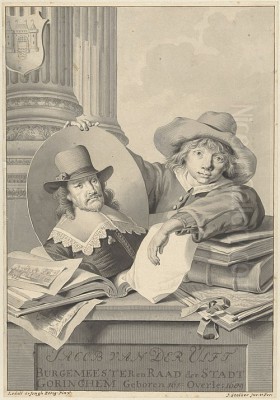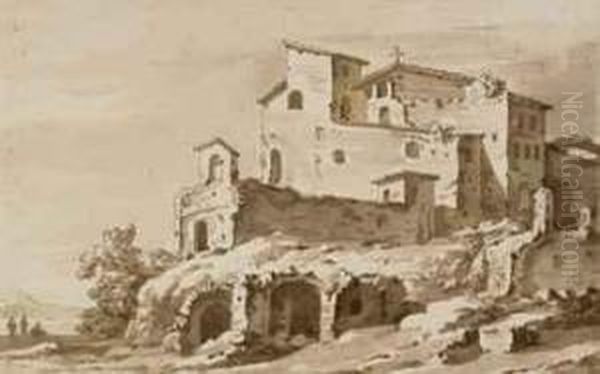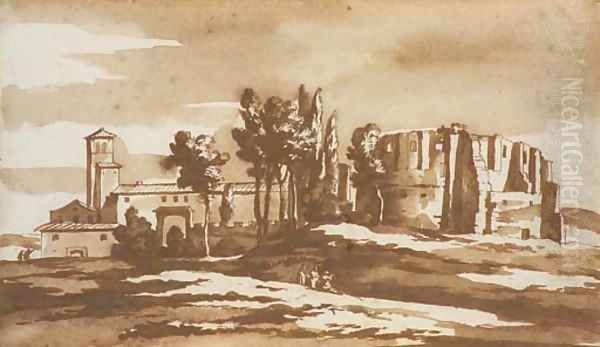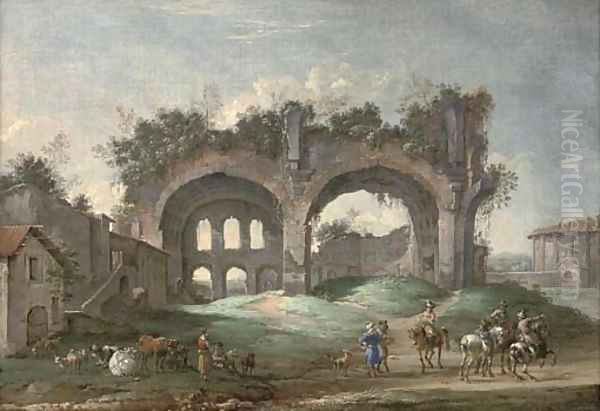
Jacob van der Ulft (1627-1689) stands as a fascinating and somewhat enigmatic figure in the rich tapestry of the Dutch Golden Age. Unlike many of his contemporaries who specialized narrowly, van der Ulft was a polymath: a painter of oils and watercolors, a skilled draughtsman, a renowned glass painter, an architect, and, for a significant period, the mayor of his native Gorinchem. His artistic legacy is primarily built upon his evocative Italianate landscapes and detailed depictions of Roman cityscapes, alongside views of Dutch towns and imaginary architectural compositions. Despite a life marked by civic duty and later by financial controversy, his artistic output, though not vast, is prized for its meticulous detail, vibrant, if sometimes idiosyncratic, use of color, and the intriguing question of how he achieved such convincing portrayals of Italy, a land he likely never visited.
Early Life and Artistic Formation in Gorinchem
Born in Gorinchem (also known as Gorkum) in 1627, Jacob van der Ulft grew up in a bustling provincial town. Details about his early artistic training are scarce, a commonality for many artists outside the major artistic centers like Amsterdam or Haarlem. There is no record of him joining a painters' guild, which often suggests an artist might have been an amateur, self-taught, or received informal instruction. Gorinchem, however, did have a tradition of glass painting, and it is plausible that van der Ulft initially honed his skills in this medium. The meticulous nature of glass painting, requiring precise design and an understanding of light and color, could well have informed his later work in other media.
His early environment would have exposed him to the flourishing art market of the Netherlands. Prints and paintings circulated widely, and even in a smaller town, an aspiring artist would have had access to reproductions of works by leading masters. It is believed that he was largely self-taught as a painter and draughtsman, developing his style through careful observation and the study of works by other artists. This independent path may account for some of the unique qualities found in his art, setting him apart from those who followed a more conventional academic apprenticeship.
The Allure of Italy: Imagined Vistas and Roman Splendor

One of the most compelling aspects of Jacob van der Ulft's oeuvre is his extensive production of Italianate landscapes and detailed views of Rome. These works, often rendered in pen and ink with watercolor washes or as oil paintings, depict famous Roman landmarks, bustling piazzas, and picturesque ruins with an air of authenticity. However, art historical consensus, notably supported by the early biographer Arnold Houbraken in his De groote schouburgh der Nederlantsche konstschilders en schilderessen (1718–1721), suggests that van der Ulft never actually traveled to Italy. This makes his Italian scenes all the more remarkable, products of a vivid imagination fueled by secondary sources.
He likely relied heavily on prints and drawings by artists who had made the journey south. The 17th century saw a surge in the popularity of Italianate landscapes among Dutch collectors, and artists like Jan Both, Nicolaes Berchem, Jan Asselijn, and Bartholomeus Breenbergh returned from Italy with sketchbooks filled with Roman views, which were then translated into paintings and widely disseminated as prints. Van der Ulft would have had access to such materials. Prints by Italian artists or by Northern European artists working in Italy, such as those by Stefano della Bella or earlier topographical views by figures like Matthäus Merian, could also have served as inspiration. His ability to synthesize these sources into coherent and atmospheric compositions speaks to his skill and artistic vision. His Roman scenes are often populated with small, lively figures, adding a sense of daily life to the ancient grandeur.
Master of Diverse Media: Painting, Drawing, and Glass
Jacob van der Ulft was not confined to a single medium; his versatility was a hallmark of his career. While his oil paintings, particularly the Italianate landscapes, are well-regarded, his drawings and watercolors form a significant and highly praised part of his output. These works on paper often exhibit a remarkable freedom of line and a sophisticated use of washes to create effects of light and shadow. His palette, whether in oil or watercolor, could be rich and warm, sometimes described as strong or even a little heavy, but always contributing to the overall vibrancy of the scene.

His reputation as a glass painter was considerable during his lifetime. He is credited by some, including Houbraken, with having rediscovered or revived the techniques of the celebrated 16th-century Gouda glass painters Dirk Crabeth and his brother Wouter Crabeth I. Van der Ulft executed numerous stained-glass windows for churches and public buildings in Gorinchem and the surrounding region. Unfortunately, much of this fragile work has not survived the ravages of time, but contemporary accounts attest to his skill in this demanding art form. The precision required for glass painting, with its emphasis on clear outlines and the interplay of colored light, likely influenced his approach to drawing and painting, particularly in the delineation of architectural forms.
Architectural Depictions and Cityscapes: Dutch and Imaginary
Beyond his Italianate fantasies, van der Ulft also turned his attention to the architecture and cityscapes of his native Netherlands, as well as creating purely imaginary architectural compositions. His Dutch scenes often depict recognizable locations, rendered with the same attention to detail seen in his Roman views. A notable example is his painting The Old Town Hall of Amsterdam on Fire (1653), which is believed to be based on a work by the renowned architectural painter Pieter Jansz. Saenredam. This painting captures a specific historical event – the fire of 1652 – and showcases his ability to handle complex architectural perspectives and dramatic lighting. Another significant work is his View of Dam Square in Amsterdam (1659), now housed in the Musée Condé, Chantilly, which provides a lively snapshot of the city's heart.
Van der Ulft also produced a number of "castle paintings," a subgenre popular in the Netherlands. These works, often drawings, depict existing or sometimes imaginary castles in landscape settings. His approach to these subjects has been compared to that of Roelant Roghman, another artist known for his topographical drawings of castles. Van der Ulft's castle scenes typically feature the structure prominently, often with a body of water in the foreground and a few small figures to animate the composition. These works demonstrate his keen eye for architectural detail and his ability to integrate buildings harmoniously within their natural surroundings. His skill as an architect, though less documented in terms of built structures, undoubtedly informed his painted and drawn representations of buildings.
A Public Life: The Mayor of Gorinchem
Jacob van der Ulft's life was not solely dedicated to art. He was a prominent citizen of Gorinchem and served multiple terms as its mayor (burgomaster) between 1660 and 1679. This civic responsibility would have been demanding, requiring considerable time and energy. It is a testament to his dedication and capacity that he managed to maintain an artistic practice alongside his public duties. His position as mayor would have placed him at the center of the town's social and political life, offering a different perspective from that of a full-time professional artist.

His involvement in civic administration also meant he was responsible for public finances and projects. This dual role as artist and administrator is unusual and adds another layer to his biography. It is possible that his architectural knowledge was put to practical use in his capacity as mayor, perhaps in overseeing public works or town planning, although specific records of such activities are limited. His standing in the community was evidently high for a considerable period, allowing him to be repeatedly elected to its highest office.
Controversy, Flight, and Later Years
Despite his long service as mayor, Jacob van der Ulft's public career ended in scandal. In 1679, he faced accusations of financial impropriety, specifically related to the administration of an orphanage's funds or, according to other sources, embezzlement from the city's tax revenues while serving as treasurer. The exact nature of the financial irregularities is somewhat obscure, but the consequences were severe. To avoid arrest or the immediate fallout, van der Ulft fled Gorinchem and sought refuge in The Hague.
This period must have been tumultuous for him, marking a dramatic downturn in his fortunes and reputation in his hometown. Although he eventually returned to Gorinchem to face the situation, the matter was not fully resolved to restore his previous standing. The financial scandal effectively ended his political career in Gorinchem. In 1683, he made a definitive move, leaving Gorinchem to settle in Noordwijk, a coastal town in North Holland. It was in Noordwijk that he spent the final years of his life, passing away in 1689. It is unclear to what extent he continued his artistic activities during these later, more troubled years, but his main body of recognized work appears to predate this period of upheaval.
Artistic Influences, Contemporaries, and Style
Van der Ulft's artistic style, while individual, shows connections to broader trends and specific artists of his time. His Italianate works, as discussed, align him with the Dutch Italianates, though his indirect method of experiencing Italy sets him apart. The influence of Jan de Bisschop (also known as Johannes Episcopius), a lawyer and amateur draughtsman who also produced Italianate scenes and published prints, is often noted. De Bisschop, like van der Ulft, was not a professional artist in the guild sense, and their shared interest in classical motifs and similar drawing styles suggest a possible connection or mutual awareness.
His topographical works and cityscapes can be seen in the context of other Dutch artists specializing in such views, like Gerrit Berckheyde and Jan van der Heyden, who were masters of depicting the urban environment with remarkable precision. While van der Ulft's cityscapes may not always achieve the same photographic clarity as these specialists, they possess a distinct charm and atmospheric quality. His landscape elements sometimes show an awareness of the work of artists like Salomon van Ruysdael, whose panoramic views were influential, and indeed, some sources suggest Ruysdael may have even referenced Ulft's panoramic landscapes.
The assertion that he imitated anonymous works by printmakers like Claes Jansz. Visscher highlights the importance of the print market in disseminating artistic ideas and compositions. For an artist potentially working in relative isolation or without formal master-pupil relationships, prints would have been an invaluable resource for learning and inspiration. His style is characterized by competent, often meticulous drawing, a vibrant, sometimes bold, color sense, and a talent for composing complex scenes, whether bustling Roman forums or serene Dutch river views.
Legacy and Art Historical Significance
In his own time, Jacob van der Ulft was likely known more for his glass painting and his civic role than for his easel paintings or drawings, which some contemporaries may have viewed as the work of a talented amateur. However, posthumously, his reputation has grown, particularly for his drawings and Italianate scenes. Art historians and collectors now appreciate the unique qualities of his work: the imaginative reconstruction of foreign lands, the detailed rendering of architecture, and the lively, often narrative, quality of his compositions.
His works are held in prestigious collections worldwide, including the Rijksmuseum in Amsterdam, the Louvre in Paris, and museums in The Hague and Berlin. This dispersal attests to the enduring appeal of his art. While the debate about his (non)-journey to Italy continues to add an element of intrigue, it ultimately does not detract from the artistic merit of the works themselves. He remains an important figure among the Dutch artists who specialized in Italianate landscapes, contributing to a genre that was highly popular in the 17th century and reflected the era's fascination with classical antiquity and the sunny climes of the South.
Jacob van der Ulft's multifaceted career—as an artist working across various media and as a public servant—presents a compelling case study of a life engaged with both the creative and civic spheres. His ability to produce such a distinctive body of work, particularly his convincing Italianate views, without the benefit of direct experience or conventional training, speaks to a remarkable artistic talent and a resourceful mind. He occupies a unique niche in Dutch art history, a testament to the diverse expressions of creativity during the Golden Age. His legacy is that of a skilled and imaginative artist whose vision transcended the geographical confines of his life, leaving behind a body of work that continues to charm and engage viewers centuries later.